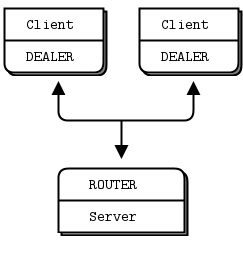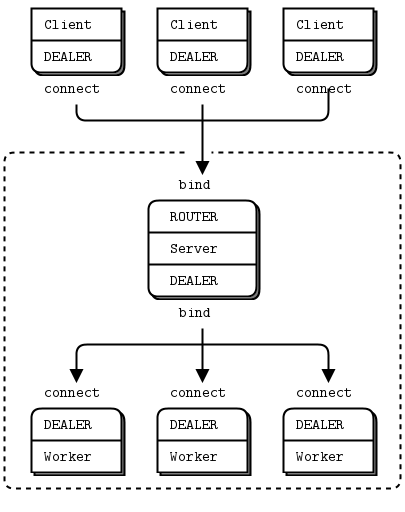ZeroMQ 비동기 클라이언트와 서버 패턴에 대한 내용으로 ZeroMQ 공식 문서를 기반으로 필요한 내용만 정리한 것이다.
이 전 글에서 ZeroMQ의 기본적인 패턴을 소개하였다. REQ-REP 패턴 위에 ROUTER와 DEALER 를 조합하는 고급 패턴을 소개한다.
ROUTER-to-DEALER 프록시를 사용하면 REQ-REP 조합을 확장하여 완전한 비동기 클라이언트 및 서버 구조를 설계할 수 있다.
REQ와 DEALER의 두 가지 구체적인 차이점을 먼저 보자.
- REQ 소켓은 항상 데이터 프레임 앞에 빈(Empty) 구분자 프레임을 보낸다. 딜러는 그렇지 않다.
- REQ 소켓은 응답을 받기 전에 하나의 메시지만 보낸다. 응답을 받을 때까지 스레드는 차단된다. 이와 반대로 DEALER는 완전히 비동기적이다.
다은은 기본적인 ROUTER to DEALER 패턴 C++ 예제 소스코드이다.
//
// Custom routing Router to Dealer
//
// Olivier Chamoux <olivier.chamoux@fr.thalesgroup.com>
#include "zhelpers.hpp"
#include <pthread.h>
static void *
worker_task(void *args)
{
zmq::context_t context(1);
zmq::socket_t worker(context, ZMQ_DEALER);
#if (defined (WIN32))
s_set_id(worker, (intptr_t)args);
#else
s_set_id(worker); // Set a printable identity
#endif
worker.connect("tcp://localhost:5671");
int total = 0;
while (1) {
// Tell the broker we're ready for work
s_sendmore(worker, "");
s_send(worker, "Hi Boss");
// Get workload from broker, until finished
s_recv(worker); // Envelope delimiter
std::string workload = s_recv(worker);
if ("Fired!" == workload) {
std::cout << "Completed: " << total << " tasks" << std::endl;
break;
}
total++;
// Do some random work
s_sleep(within(500) + 1);
}
return NULL;
}
// While this example runs in a single process, that is just to make
// it easier to start and stop the example. Each thread has its own
// context and conceptually acts as a separate process.
int main() {
zmq::context_t context(1);
zmq::socket_t broker(context, ZMQ_ROUTER);
broker.bind("tcp://*:5671");
srandom((unsigned)time(NULL));
const int NBR_WORKERS = 10;
pthread_t workers[NBR_WORKERS];
for (int worker_nbr = 0; worker_nbr < NBR_WORKERS; ++worker_nbr) {
pthread_create(workers + worker_nbr, NULL, worker_task, (void *)(intptr_t)worker_nbr);
}
// Run for five seconds and then tell workers to end
int64_t end_time = s_clock() + 5000;
int workers_fired = 0;
while (1) {
// Next message gives us least recently used worker
std::string identity = s_recv(broker);
{
s_recv(broker); // Envelope delimiter
s_recv(broker); // Response from worker
}
s_sendmore(broker, identity);
s_sendmore(broker, "");
// Encourage workers until it's time to fire them
if (s_clock() < end_time)
s_send(broker, "Work harder");
else {
s_send(broker, "Fired!");
if (++workers_fired == NBR_WORKERS)
break;
}
}
for (int worker_nbr = 0; worker_nbr < NBR_WORKERS; ++worker_nbr) {
pthread_join(workers[worker_nbr], NULL);
}
return 0;
}
ROUTER to DEALER 의 패턴으로 한 서버가 여러 작업자와 비동기식으로 대화하는 1 대 N 사용 사례를 다양한 클라이언트가 단일 서버와 통신하고 이를 비동기적으로 수행하는 N 대 1 아키텍처로 뒤집을 수 있다.

작동 방식은 다음과 같다.
- 클라이언트는 서버에 연결하고 요청을 보낸다.
- 각 요청에 대해 서버는 0 개 이상의 응답을 보낸다.
- 클라이언트는 응답을 기다리지 않고 여러 요청을 보낼 수 있다.
- 서버는 새로운 요청을 기다리지 않고 여러 개의 회신을 보낼 수 있다.
다음은 비동기 client/server in C++ 예제 소스코드이다.
// Asynchronous client-to-server (DEALER to ROUTER)
//
// While this example runs in a single process, that is to make
// it easier to start and stop the example. Each task has its own
// context and conceptually acts as a separate process.
#include <vector>
#include <thread>
#include <memory>
#include <functional>
#include <zmq.hpp>
#include "zhelpers.hpp"
// This is our client task class.
// It connects to the server, and then sends a request once per second
// It collects responses as they arrive, and it prints them out. We will
// run several client tasks in parallel, each with a different random ID.
// Attention! -- this random work well only on linux.
class client_task {
public:
client_task()
: ctx_(1),
client_socket_(ctx_, ZMQ_DEALER)
{}
void start() {
// generate random identity
char identity[10] = {};
sprintf(identity, "%04X-%04X", within(0x10000), within(0x10000));
printf("%s\n", identity);
client_socket_.setsockopt(ZMQ_IDENTITY, identity, strlen(identity));
client_socket_.connect("tcp://localhost:5570");
zmq::pollitem_t items[] = {
{ static_cast<void*>(client_socket_), 0, ZMQ_POLLIN, 0 } };
int request_nbr = 0;
try {
while (true) {
for (int i = 0; i < 100; ++i) {
// 10 milliseconds
zmq::poll(items, 1, 10);
if (items[0].revents & ZMQ_POLLIN) {
printf("\n%s ", identity);
s_dump(client_socket_);
}
}
char request_string[16] = {};
sprintf(request_string, "request #%d", ++request_nbr);
client_socket_.send(request_string, strlen(request_string));
}
}
catch (std::exception &e) {}
}
private:
zmq::context_t ctx_;
zmq::socket_t client_socket_;
};
// Each worker task works on one request at a time and sends a random number
// of replies back, with random delays between replies:
class server_worker {
public:
server_worker(zmq::context_t &ctx, int sock_type)
: ctx_(ctx),
worker_(ctx_, sock_type)
{}
void work() {
worker_.connect("inproc://backend");
try {
while (true) {
zmq::message_t identity;
zmq::message_t msg;
zmq::message_t copied_id;
zmq::message_t copied_msg;
worker_.recv(&identity);
worker_.recv(&msg);
int replies = within(5);
for (int reply = 0; reply < replies; ++reply) {
s_sleep(within(1000) + 1);
copied_id.copy(&identity);
copied_msg.copy(&msg);
worker_.send(copied_id, ZMQ_SNDMORE);
worker_.send(copied_msg);
}
}
}
catch (std::exception &e) {}
}
private:
zmq::context_t &ctx_;
zmq::socket_t worker_;
};
// This is our server task.
// It uses the multithreaded server model to deal requests out to a pool
// of workers and route replies back to clients. One worker can handle
// one request at a time but one client can talk to multiple workers at
// once.
class server_task {
public:
server_task()
: ctx_(1),
frontend_(ctx_, ZMQ_ROUTER),
backend_(ctx_, ZMQ_DEALER)
{}
enum { kMaxThread = 5 };
void run() {
frontend_.bind("tcp://*:5570");
backend_.bind("inproc://backend");
std::vector<server_worker *> worker;
std::vector<std::thread *> worker_thread;
for (int i = 0; i < kMaxThread; ++i) {
worker.push_back(new server_worker(ctx_, ZMQ_DEALER));
worker_thread.push_back(new std::thread(std::bind(&server_worker::work, worker)));
worker_thread->detach();
}
try {
zmq::proxy(static_cast<void*>(frontend_),
static_cast<void*>(backend_),
nullptr);
}
catch (std::exception &e) {}
for (int i = 0; i < kMaxThread; ++i) {
delete worker;
delete worker_thread;
}
}
private:
zmq::context_t ctx_;
zmq::socket_t frontend_;
zmq::socket_t backend_;
};
// The main thread simply starts several clients and a server, and then
// waits for the server to finish.
int main (void)
{
client_task ct1;
client_task ct2;
client_task ct3;
server_task st;
std::thread t1(std::bind(&client_task::start, &ct1));
std::thread t2(std::bind(&client_task::start, &ct2));
std::thread t3(std::bind(&client_task::start, &ct3));
std::thread t4(std::bind(&server_task::run, &st));
t1.detach();
t2.detach();
t3.detach();
t4.detach();
getchar();
return 0;
}
예제에서 서버는 워커 스레드를 만들고 스레드는 하나의 요청을 동기적으로 처리한다. 내부 대기열을 사용하여 이를 프론트 엔드 소켓에 연결한다. zmq_proxy() 함수를 호출하여 프론트엔드 및 백엔드 소켓을 연결한다.

클라이언트와 서버 사이에서 DEALER to ROUTER 패턴으로 통신하고 있지만 서버 내부의 메인 스레드에서는 DEALER to DEALER 를 사용하고 있다. 워커가 엄격하게 동기화 되어야할 필요가 있는 경우 REP 를 사용할 수 있지만 여러 개의 답장을 비동기로 보내려면 DEALER 소켓이 필요하다. 다음은 이것을 수평적으로 나타낸 것이다.

클라이언트는 단일 프레임으로 구성된 메시지를 보낸다. 서버 스레드는 2 프레임 메시지 (클라이언트 ID가 접두어로 붙은 원본 메시지)를 받는다. 그런 다음 워커는 첫 번째 프레임을 ID로 사용하여 두 번째 프레임에 데이터를 넣고 클라이언트에 다시 보낼 수 있다. ROUTER는 메세지를 해당 클라이언트로 라우팅 한다.

 Qt와 GStreamer 로 작성한 flac 오디오 재생 예제
Qt와 GStreamer 로 작성한 flac 오디오 재생 예제
 ZeroMQ의 기본 메세지 패턴들
ZeroMQ의 기본 메세지 패턴들











